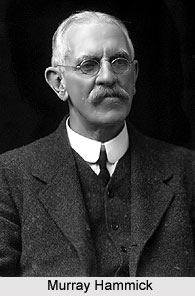 Murray Hammick, officially known as Sir Murray Love Hammick KCSI CIE, served as the Acting Governor of Madras Presidency in the year 1912, in the erstwhile undivided India under the rule of the British Empire. He was a well known British colonial administrator. Hammick also served as one of the members of the British Indian Civil Service, which was the civil service of the Government of India during the era of the rule of British Empire in India. The members of the civil service were appointed under Section XXXII of the Government of India Act, 1858 of the Parliament of the United Kingdom. After the year 1886, the Indian Civil Service was officially known as Imperial Civil Service.
Murray Hammick, officially known as Sir Murray Love Hammick KCSI CIE, served as the Acting Governor of Madras Presidency in the year 1912, in the erstwhile undivided India under the rule of the British Empire. He was a well known British colonial administrator. Hammick also served as one of the members of the British Indian Civil Service, which was the civil service of the Government of India during the era of the rule of British Empire in India. The members of the civil service were appointed under Section XXXII of the Government of India Act, 1858 of the Parliament of the United Kingdom. After the year 1886, the Indian Civil Service was officially known as Imperial Civil Service.
Early Life of Murray Hammick
Murray Hammick was born on May 11, 1854 to father Reverand Sir Vincent Love Hammick and Mary Alexander. He successfully completed his graduation from the Fell King`s College. Later he passed the entrance examination and joined the British Indian Civil Service (ICS).
Career of Murray Hammick
Sir Murray Love Hammick KCSI CIE came to British India on 18 December 1877. He was appointed as Sub Collector in the Madras Presidency and also as Asssistant Commissioner of Coorg. Later he served as the Inspector General of Police of Madras (now Chennai) from the year 1894 to 1906. In the same year, Hammick became the Chief Secretary to the Madras government. In the year 1908, Murray Hammick was assigned to the Executive Council of the Governor of Madras. He acted in the position from the year 1908 to 1912.
Murray Hammick was appointed as the acting Governor of Madras Presidency on March 30, 1912. He succeeded Thomas David Gibson-Carmichael, 1st Baron Carmichael GCSI, GCIE, KCMG, DL who retired as the Governor of Madras on 30 March 1912. The Madras Presidency, also known as the Presidency of Fort St. George and Madras Province, was an administrative sub division of British dominated India. The territory included most of southern India, such as the modern states of Tamil Nadu, the Coastal Andhra and Rayalaseema regions of Andhra Pradesh, Lakshadweep Islands, the Malabar region of North Kerala, Koraput, Malkangiri, Nabarangapur and Gajapati districts of southern Orissa and the Bellary, Ganjam, Dakshina Kannada, Rayagada and Udupi districts of Karnataka. Sir Murray Love Hammick KCSI CIE served in office until October 30, 1912 and was succeeded by John Sinclair, 1st Baron Pentland, GCSI, GCIE.
In the year 1913, Murray Hammick was appointed as a member of the Royal Commission to enquire into the Civil Services in India. Later in 1915, he was appointed to the Council of State and served as a member from the year 1915 to 1922.
Personal Life of Murray Hammick
Sir Murray Love Hammick KCSI CIE was married to Ada Constance Searle on 11 December 1883. She was the daughter of Major General Arthur Thaddeus Searle. Hammick had 2 sons and 3 daughters, namely Lorna Mary Hammick, Dorothy Constance Hammick, Lucy Mabel Hammick, Major Henry Alexander Hammick, OBE, MC and John Murray Hammick.
Honours of Murray Hammick
Murray Hammick was knighted with Companion of the Most Eminent Order of the Indian Empire (CIE) in the year 1901 and Companion of the Most Exalted Order of the Star of India (CSI) in 1907. He was made a Knight Commander of the Most Exalted Order of the Star of India (KCSI) in the year 1911.



















